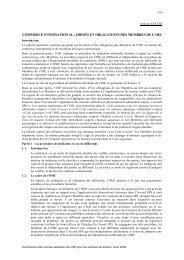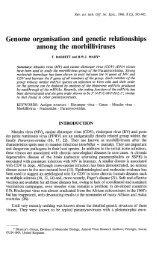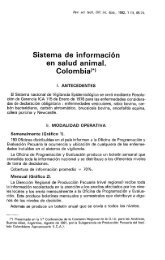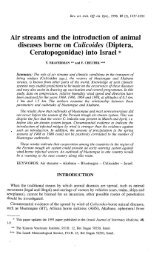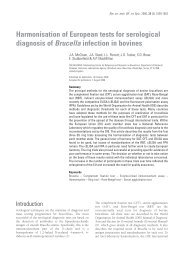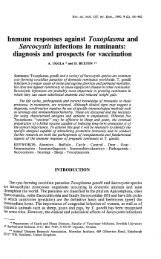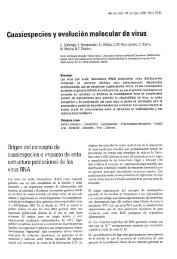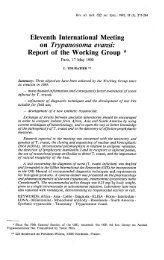Clinical variation in foot and mouth disease: sheep and goats
Clinical variation in foot and mouth disease: sheep and goats
Clinical variation in foot and mouth disease: sheep and goats
You also want an ePaper? Increase the reach of your titles
YUMPU automatically turns print PDFs into web optimized ePapers that Google loves.
506 Rev. sci. tech. Off. <strong>in</strong>t. Epiz., 21 (3)<br />
A5/Allier/60<br />
A22/IRQ/24/64<br />
A22/IND/300/94<br />
A/SAU/16/95<br />
17.9%<br />
A/SAU/19/95<br />
A/SAU/24/95<br />
A/SAU/35/94<br />
A/TUR/3/95<br />
18 16 14 12 10 8 6 4 2 0<br />
Percentage nucleotide difference (nt 475-639 of VP1)<br />
Fig. 1<br />
Dendrogram show<strong>in</strong>g the close genomic relationship between <strong>foot</strong> <strong>and</strong> <strong>mouth</strong> <strong>disease</strong> serotype A isolates from India <strong>and</strong> Saudi Arabia<br />
(N.J. Knowles, personal communication)<br />
has also been isolated from goat samples submitted from<br />
Bangladesh <strong>and</strong> <strong>goats</strong> imported from this country were<br />
responsible for an outbreak of Asia 1 <strong>in</strong> Kuwait. Isolation of<br />
other serotypes is rare, but does not necessarily <strong>in</strong>dicate that<br />
<strong>in</strong>fection of small rum<strong>in</strong>ants with these serotypes does not<br />
occur; for example, Kuwait reported isolat<strong>in</strong>g South African<br />
Territories (SAT 2) virus from <strong>sheep</strong> dur<strong>in</strong>g the <strong>in</strong>cursion of<br />
FMD <strong>in</strong>to Saudi Arabia dur<strong>in</strong>g 2000. However, even <strong>in</strong> East<br />
Africa, where outbreaks due to serotypes O, A, C, SAT 1 <strong>and</strong> 2<br />
are common, predom<strong>in</strong>antly serotype O virus was identified <strong>in</strong><br />
cl<strong>in</strong>ically affected <strong>sheep</strong> <strong>and</strong> <strong>goats</strong>.<br />
Transmission<br />
As is the case with other rum<strong>in</strong>ants, <strong>sheep</strong> <strong>and</strong> <strong>goats</strong> are highly<br />
susceptible to <strong>in</strong>fection with FMD virus by the aerosol route,<br />
with as little as 20 TCID 50 (tissue culture <strong>in</strong>fectious doses) be<strong>in</strong>g<br />
sufficient for <strong>in</strong>fection. Aerosol production by <strong>in</strong>fected pigs can<br />
be as high as log 10 8.6 TCID 50 per day, theoretically sufficient to<br />
<strong>in</strong>fect over 20 million <strong>sheep</strong>. Aerosol production by <strong>in</strong>fected<br />
<strong>sheep</strong>, however, is considerably less, <strong>and</strong> whereas there are<br />
reports of airborne virus spread<strong>in</strong>g from pigs over 250 km to<br />
<strong>in</strong>fect cattle (France to Engl<strong>and</strong> <strong>in</strong> 1981) (5), aerosol<br />
PAK/1/54<br />
TAI/2/95<br />
IND/26/95<br />
14.8%<br />
IND/40/95<br />
IND/233/95<br />
IND/43/95<br />
SAU/39/94<br />
SAU/40/94<br />
IND/51/95<br />
18 16 14 12 10 8 6 4 2 0<br />
Percentage nucleotide difference (nt 475-636 of VP1)<br />
Fig. 2<br />
Dendrogram show<strong>in</strong>g the close genomic relationship between <strong>foot</strong> <strong>and</strong> <strong>mouth</strong> <strong>disease</strong> serotype Asia 1 isolates from India <strong>and</strong> Saudi Arabia<br />
(N.J. Knowles, personal communication)<br />
© OIE - 2002





